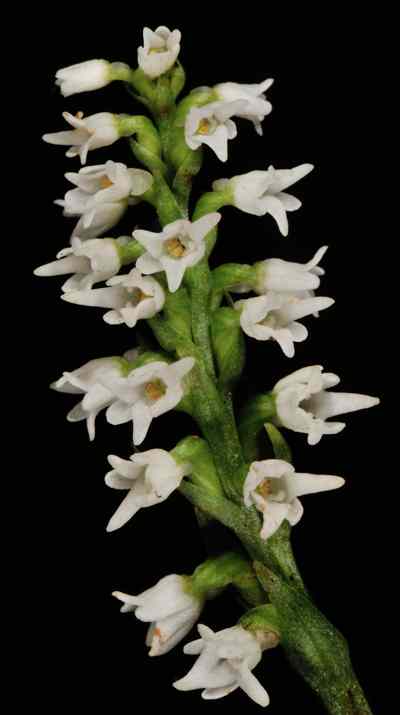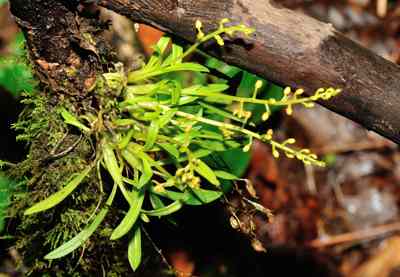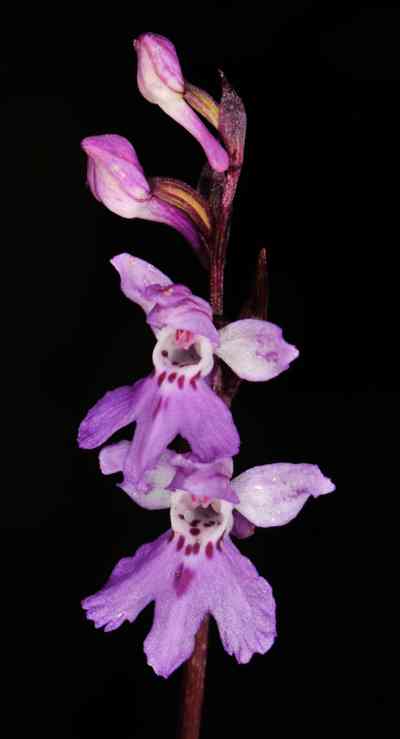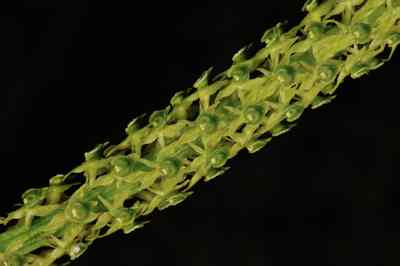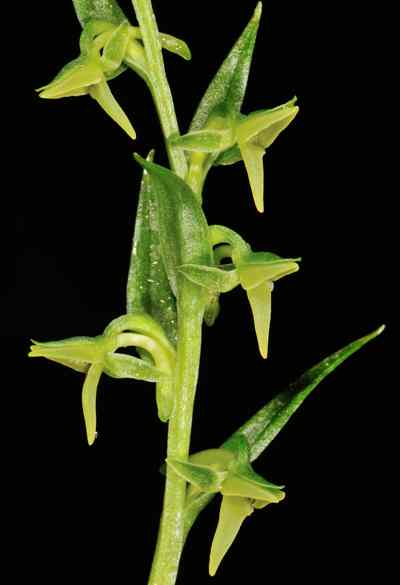The Plant
Grows on moss covered dead tree trunks. Whole plant 15 to 25 cm in height. Tubers cylindrical, about 2 to 3 cm long, with one or two stout roots arising from the base of the stem. Stem less than half in length of the whole plant, stout with one or two tubular sheaths at its base. Leaf two, unequal, the lower one the largest, elliptic, acute, veined, base narrowed to a short tubular sheath, diagonally erect. Flower many, arranged laxly on a long spike.
The Flower
Flower large, 3 to 4 cm across. Sepals unequal; dorsal triangular to ovate, with broad base and acute apex, smaller than the lateral sepals, three veined, erect; lateral linear to oblong, twice as long as the dorsal, spreading initially, then twisting and curving. Petals longer than the dorsal sepal but smaller than the lateral; lanceolate with broad base and narrowing to its apex, acute, curving back. Lip longer than all other flower parts except its spur, lanceolate, rigid, pointing downwards. Spur cylindrical, longer than the ovary, curved forward at its apex. Floral bract longer than the short beaked and twisted ovary, diminishing in length to the apex of the spike, arising from the lower portion of the ovary.
Whole flower pale yellowish green with its spur of a much paler shade. Floral bract green.

The Pursuit
In the monumental work of King and Pantling, there was no mention of any Habenaria (at that time this species was with genus Habenaria) growing on moss covered fallen tree trunks. As I followed their text, I never expected anything like that from the region. By accident I spotted few small plants growing on a moss covered fallen tree trunk deep inside a forested area. The plants were so small to identify, but they got all the features of an orchid species. I decided to mark the area and visit it after around 10 days. As I was returning from those deep-forested area, I slipped over a rock, injuring my left shoulder and knee and also damaging my flash, which I was carrying in my backpack. After doing first aid there, I returned to the camp limping.
On the 12th day, accompanied by the forest official I again visited the location to study those plants. The plants attained and were with few small buds. That growth was enough to identify the species. I was really happy to understand its various characteristics. I understood after a close study of the plant that it would take another 10 to 12 days for the buds to be in bloom. While we were returning, I had another fall from the same rock of the previous trip. This time even though my camera accessories were safe I got few cuts on my left arm, chest and knees. My friend was kind enough to help me and to clean the wounds. While he was doing first aid I explained to him the incident happened at the same location on my previous visit. He then came up with several fictitious stories and theories, to explain what I had experienced. He shared a short story of a person thrown into a gorge recently very much near by. Even though I did not totally agree with him I accepted the fact that places in the Himalayas are known for strange experience. Once again me I returned home with a limping leg.
On the proposed day of our next visit, I was left with no option other than to trek all alone as my friend was not available. However, some or other reasons made me abandon the trip. My friend returned only after 6 days and we proceeded to the location the very next day. To my agony, I found most of the flowers withered. I was forced to study and document those withered flowers. The lost opportunity made both of us speechless all the way back. As we approached the rock where I slipped twice, we both were cautious. The anxiety made both of us glance at each other several times. He was the first to climb up the rock and to our shock, he was thrown to the other side as if there was somebody sitting on top of the rock and pushing him down. Even though totally helpless and strength less by the incident, I was forced to jump across and help him to get back to the trek route. Even though he hasn’t got any cuts, he was quite frightened. We gathered all our strength to walk out of that area at the quickest possible way we could. Till the end of that season we never ventured to visit that location again.
Like the mystery of the three falls we experienced together, the mystery of this species remains. I never encountered this species till date.
Reference:
King, G. & Pantling, R. (1898). The Orchids of the Sikkim-Himalayas. Ann. Roy. Bot. Garden. (Calcutta). Habenaria sikkimensis Hook. Page no: 317.
